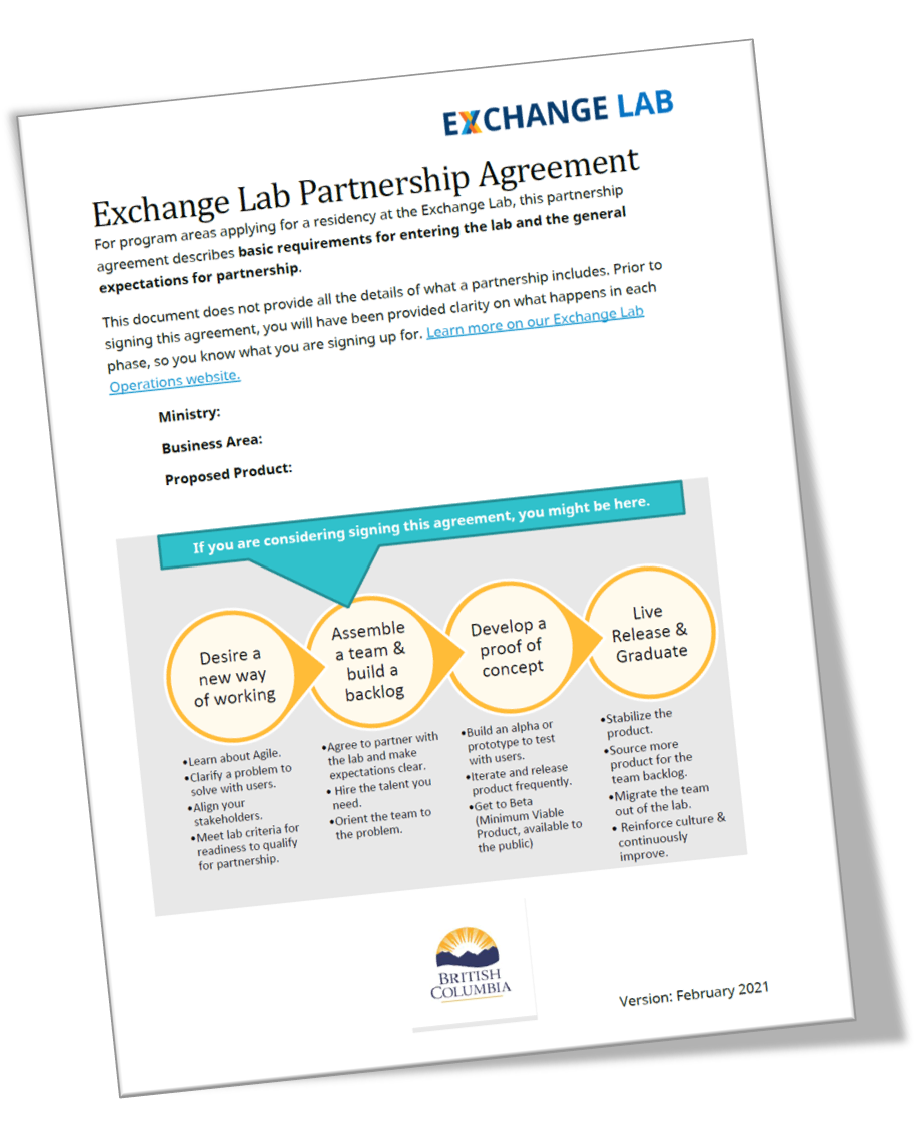Apply to the Lab
During this phase, a program area becomes more clear on what they need to solve for and how they will shift their approach in partnering with the Exchange.
Pre-conditions:
- You’ve spent some time getting familiar with the Service Design and Delivery standard, and service innovation methods, including Agile Delivery.
- Your organization needs support to build its capacity for digital service delivery using modern methods and tools (there isn’t enough support for this in your home organization.)
- You’ve read the Lab Partnership Agreement and believe your organization can be supported to align to it.
What success looks like in this phase:
- You are able to clarify why Agile product delivery might be appropriate for the service delivery challenge you are seeking to solve.
- Your leadership has engaged with the leadership team at the Exchange Lab to confirm the program and product is likely a good candidate for receiving support from the Exchange Lab.
- Your program area and service delivery challenge sufficiently meets the readiness criteria set by the lab (explained below)
Applicable Standards:
Define a Problem
Teams that partner with the lab are ready to get started solving a real problem that is complex.
Adopting or implementing new technology can be challenging, or desirable, but that is not what we help teams solve for. We solve for complex challenges to service delivery that lead to greater public impact. This impact includes:
- delivering better services that meet the needs of citizens; and
- enabling government to deliver services in better, cost effective ways.
We help teams develop readiness around problem definition through these steps:
- Answer focused questions about he potential problem in a Challenge Brief Template
- Explore the nature of the problem with experts in service delivery connected through the Digital Delivery Network (we facilitate a workshop)
- Get clear on root cause analysis if the source of the problem is not clear, and identify a place to start solving the problem from.
Confirm Priority
Teams that partner with the lab have senior level executive support (up to the ADM).
Sometimes, program staff approach before they have this support, but they have clarity of the problem they want to solve, or can point to value they want to achieve. We support program areas to confirm priority a few ways:
- Define the problem as described above, to help build a case for the opportunity to work with the Lab on a real, complex challenge.
- Determine an opportunity to “path find” a solution to a problem that is common and can be leveraged by others with significant return on investment.
Ultimately, if the problem or opportunity appears to be a good investment of Exchange Lab resources, our team will test it with others in the Digital Delivery Network and with OCIO Executive. This may result in advancing towards a partnership.
If the problem is not one the Exchange Lab will resource, the program will be supported to engage with the digital delivery network and innovation community to make progress in other ways.
Identify Capacity
Teams that partner with the Lab are ready to fund an Agile product team and support the continuous improvement of a product.
While other methods of IM/IT development treat technology development as a “project” with an end date, to keep up with technology and people’s expectations, programs need to take a “product mindset.” This means recognizing commitment to a few key changes in your organization:
- Confirmation of a full time Product Owner who will manage the product (and a potential portfolio of products) ongoing.
- Commitment to hire at least one DevOps Specialist or Site Reliability Engineer who will ensure the product continues to improve and evolve with emerging security and application hosting requirements.
- Potential capital spending to build the first version of working software, and ongoing operational (program) funding to sustain and continuously improve the product.
- Commitment to align other functions in the organization to support this new way of working (change management).
In many cases, this commitment can only be confirmed through the approval of Digital Investment Board funding or Treasury Board funding (and often both). It may be possible to realign resources within an operational budget or within existing capital allocations.
LabOps Resources
- Challenge Brief Template
- Partnership Agreement template
- Diagram of Readiness Criteria & optional readiness support functions of the Digital Delivery Network
- Exchange Lab Service Blueprint (TBC)
- Organizational Design Guidelines (TBC)
- Application hosting expectations (TBC)
- Finance guidelines (TBC)

